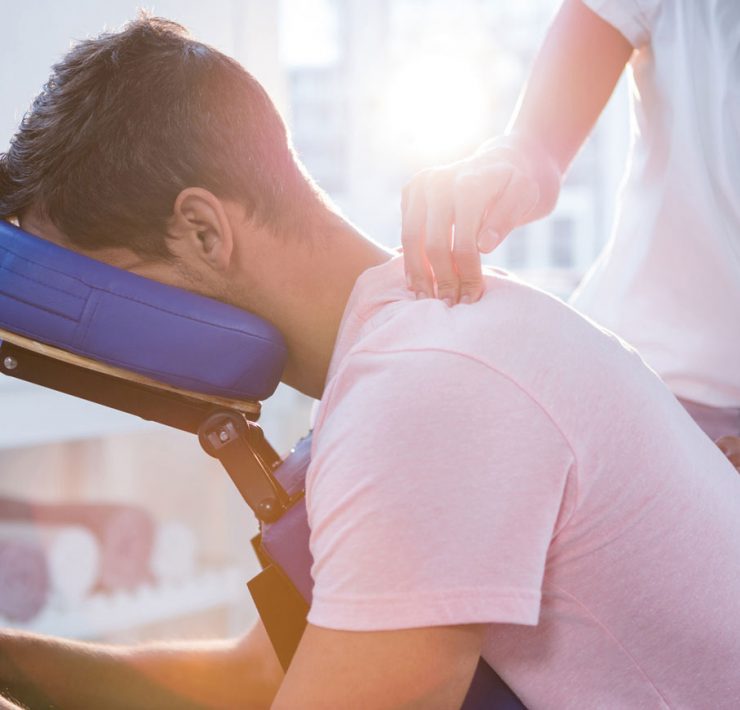When you think of ergonomics — the study of people in their working conditions — you probably picture a corporate wellness consultant making an assembly line more efficient. But ergonomics in an office setting can be just as important for productivity and wellness. Neglecting these possibilities for safety and efficiency can lead to long-term health concerns for your employees. But cultivating a healthy, ergonomic work environment can be both affordable and easy.
These 10 simple steps will help you bring awareness to ergonomic basics like posture, stretching, and the physical setup of your workspace, so your employees can feel more comfortable and productive without risking injury and burnout.
Easy Adjustments for Employees to Make
1. Adjust your monitor height
Experts say that for ideal ergonomic monitor height, the top of your computer screen should be close to eye level. Looking at the middle of the screen should bring your eyes slightly downward, without having to tilt your head. Generally, your monitor should be at about an arm’s length from your face.
2. Adjust your chair height
Most office chairs are already adjustable, so take advantage of that lever hiding underneath your seat. When sitting facing your desk, make sure your thighs are parallel to the floor and your feet lie flat comfortably. Your arms should be able to rest easily on the surface of your desk, within reach of your keyboard and mouse.
3. Focus on posture
Poor posture creates unnecessary stress on the spine, which can lead to chronic pain and lasting health issues. Sit close enough to your desk that you don’t have to reach to access your workspace, and make sure the weight of your arms is fully supported by the desk itself. Adjusting your monitor and chair height in combination with a comfortable distance between your chair and the desk should make it easy to sit up straight and maintain proper posture.
Accessories to Improve Comfort
4. Standing desk
If standing desks are in the budget, they’re a great addition to your employees’ workstations. Benefits of standing desks include improved cardiovascular health, reduced risk of obesity and metabolic disorders, increased energy levels, and better overall health. Sit-stand desks also add a touch of variety by allowing employees to alternate between sitting and standing throughout the day, without ever sacrificing good ergonomic practices. If you’re looking to test the waters with a standup working environment, here are our favorite standing desks for every budget.
5. Floor mat
Once employees switch to standing desks, it’s important to support the ergonomics of good upright posture with an anti-fatigue mat. The sudden switch to a day on your feet can prove difficult without a little cushion, so choose a mat that has a little give, without being too soft. This helps your feet, ankles, legs, and back get used to the new body position.
6. Wrist rests
When selected carefully, keyboard wrist rest pads can help prevent carpal tunnel and chronic pain in the hands, wrists, and arms. Make sure to choose wrist rests that elevate your hands to the level of the keyboard, but don’t force your wrists to stretch upwards before making your fingers reach downwards. The goal is to take pressure off the arms and shoulders, reducing the risk of headaches and neck pain.
7. Ergonomic keyboard
Ergonomic keyboards are specifically designed to relieve stress in the hands, wrists, arms, and shoulders for any employee who types constantly (see: everyone in 2017). Scientific communities still debate whether or not ergonomic keyboards can actually help prevent carpal tunnel and other repetitive strain injuries, but there are a number of factors to consider if you’d like to give it a shot. Look for a keyboard with a palm rest, separate letter pads for the left and right hands, a distinct number pad, and a molded shape that keeps your hands and fingers in a natural, relaxed position while typing.
Healthy Habits to Build As a Team
8. Take stretch breaks
Stretching throughout the day is an important way to prevent repetitive strain injuries, poor posture, and employee burnout. Encourage stretching as a team to avoid awkward glances and unwarranted attention, and to create healthy camaraderie among employees. Make sure to stretch your wrists, shoulders, arms, and neck, and throw in a 60-second breathing exercise to decrease stress.
9. Host a chair massage event
Chair massage is a great way to break up the stress and pressure of the workweek with a little well-earned relaxation. Benefits of chair massage include increased circulation and flexibility, boosted morale, and improved productivity. On the company level, providing regular perks like in-office massages can also reduce employee turnover rates — 59% of employees say they’ll be more loyal to an employer who looks after their health and wellness. Zeel makes it easy for employees to schedule themselves for a massage session directly in the mobile app, eliminating company-wide scheduling and logistics pains.
10. Offer hand massage
Since many employees in today’s digital age spend countless hours typing away at computers, hand massage is a great way to get straight to troubled areas like the wrists, joints, and fingers. Carpal tunnel syndrome is often treated with massage therapy to ease muscle stress and tension from the fingertips to the forearms — reducing friction and eliminating pain. If you’re booking this type of massage on-demand, be sure to mention to your Zeel Massage Therapist that you’re experiencing hand pain so they can focus attention where you need it most.
Looking to start a corporate wellness program? Learn more about chair massage in the workplace.
Zack is a writer, producer and marketer with 10+ years' experience in the advertising, nonprofit and tech startup industries. He is currently the Education Production Team Lead at Foundr Magazine, a web site for entrepreneurship education and was previously Content Manager at Zeel. Learn more about Zack on LinkedIn.







